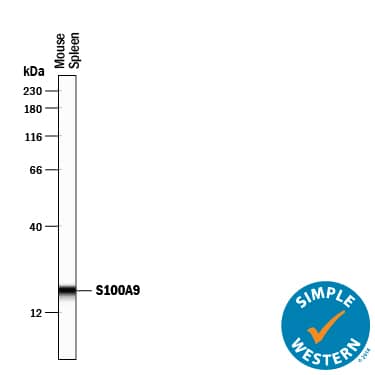Mouse S100A9 Antibody
R&D Systems, part of Bio-Techne | Catalog # MAB2065

Key Product Details
Species Reactivity
Validated:
Cited:
Applications
Validated:
Cited:
Label
Antibody Source
Product Specifications
Immunogen
Met1-Lys113
Accession # P31725
Specificity
Clonality
Host
Isotype
Scientific Data Images for Mouse S100A9 Antibody
Detection of Mouse S100A9 by Western Blot.
Western blot shows lysates of mouse leukocytes. PVDF membrane was probed with 2 µg/mL of Rat Anti-Mouse S100A9 Monoclonal Antibody (Catalog # MAB2065) followed by HRP-conjugated Anti-Rat IgG Secondary Antibody (HAF005). A specific band was detected for S100A9 at approximately 14 kDa (as indicated). This experiment was conducted under reducing conditions and using Immunoblot Buffer Group 1.Detection of Mouse S100A9 by Simple Western™
Simple Western lane view shows lysates of mouse spleen tissue, loaded at 0.2 mg/mL. A specific band was detected for S100A9 at approximately 19 kDa (as indicated) using 10 µg/mL of Rat Anti-Mouse S100A9 Monoclonal Antibody (Catalog # MAB2065) followed by 1:50 dilution of HRP-conjugated Anti-Rat IgG Secondary Antibody (Catalog # HAF005). This experiment was conducted under reducing conditions and using the 12-230 kDa separation system.Applications for Mouse S100A9 Antibody
Simple Western
Sample: Mouse spleen tissue
Western Blot
Sample: Mouse lung tissue
Formulation, Preparation, and Storage
Purification
Reconstitution
Formulation
Shipping
Stability & Storage
- 12 months from date of receipt, -20 to -70 °C as supplied.
- 1 month, 2 to 8 °C under sterile conditions after reconstitution.
- 6 months, -20 to -70 °C under sterile conditions after reconstitution.
Background: S100A9
S100A9, also known as calgranulin B or migration inhibitory factor-related protein 14 (MRP14), belongs to the S100 family of calcium binding proteins of the EF-hand type. It is highly expressed in myeloid cells and other cell types including keratinocytes, epithelial cells and endothelial cells. S100A9 is a cytosolic protein that can also be released into the extracellular milieu. It is associated with various inflammatory diseases.
Long Name
Alternate Names
Gene Symbol
UniProt
Additional S100A9 Products
Product Documents for Mouse S100A9 Antibody
Product Specific Notices for Mouse S100A9 Antibody
For research use only

